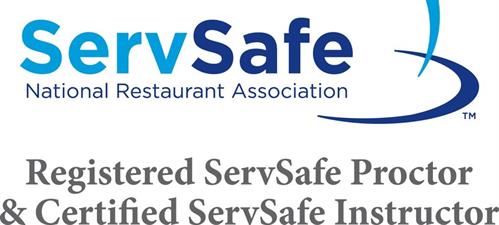Quick Tips for Successfully Completing Your ServSafe Food Handler Program Online
Quick Tips for Successfully Completing Your ServSafe Food Handler Program Online
Blog Article
Comprehensive Food Handlers Training for Hygiene and Safety
In today's rapidly progressing food service landscape, thorough food handlers training has emerged as an important element for guaranteeing health and security. By instilling important practices associated to hand health, food storage space, and sanitation, this training not just reduces the threat of foodborne health problems but likewise strengthens compliance with regulatory standards. The implications of such training expand beyond simple compliance; they discuss public wellness and customer trust fund. Yet, the efficiency of these training programs can vary considerably. What aspects truly establish their success in cultivating a culture of safety and security?
Importance of Food Security Training

Furthermore, food safety training helps to guarantee that employees understand existing policies and guidelines, which are essential for keeping functional licenses and preventing pricey charges. Regular training sessions additionally serve as a system for enhancing best techniques, thus reducing the chance of human mistake, which usually works as a leading cause of food contamination.
In addition, purchasing food safety and security training can boost a facility's reputation, as consumers increasingly prioritize dining experiences that mirror high safety and security standards. Such positive procedures not just shield customers yet also add to the lasting success of food organizations. In recap, detailed food safety training is a vital element of food solution operations, straight affecting both public health and wellness and organization sustainability.
Key Principles of Health
Preserving high standards of hygiene is vital in any type of food managing environment to protect against contamination and make certain the security of consumers. The key principles of health encompass numerous essential practices that food trainers should constantly use.
First, hand hygiene is critical; food handlers need to wash their hands extensively with soap and water before and after handling food, in addition to after using the restroom or touching any type of possibly infected surfaces. Devices and surfaces need to be routinely cleansed and disinfected to eliminate pathogens. This includes utensils, cutting boards, and kitchen counters, which need to be maintained in a clean condition.


Appropriate food storage is additionally important; raw foods must be saved separately from prepared or ready-to-eat things to stay clear of cross-contamination. servsafe food handler. Furthermore, keeping proper temperature controls is important; disposable things need to be kept at safe temperature levels to prevent bacterial growth
Lastly, personal hygiene can not be ignored. Food trainers must put on clean clothing, use hair restrictions, and stay clear of working when ill. By adhering to these vital concepts of hygiene, food trainers can substantially minimize the risk of foodborne ailments and promote a much safer eating experience for all consumers.
Usual Foodborne Ailments
Although many foodborne health problems can be protected against through appropriate health and safe food handling techniques, they stay a significant public wellness issue. Foodborne pathogens can lead to a selection of ailments, varying from moderate gastrointestinal distress to serious issues and even death.
Common foodborne ailments include salmonellosis, brought on by Salmonella microorganisms, often connected to undercooked fowl and eggs. One more widespread disease is listeriosis, linked with raw milk items and ready-to-eat meats, which can be specifically harmful for immunocompromised individuals and pregnant women. Norovirus, often gotten investigate this site from infected food or surfaces, is recognized for its rapid spread and capacity to create outbreaks in communal settings.
Escherichia coli (E. coli) infection, significantly related to undercooked ground beef and contaminated fruit and vegetables, can lead to extreme abdominal pains and kidney failure in some cases. In addition, Clostridium perfringens, frequently discovered in large quantities of food that are poorly saved, can trigger food poisoning with signs and symptoms showing up quickly after intake.
Comprehending these diseases is essential for food handlers, as understanding can considerably minimize the risk of contamination and protect public wellness. Appropriate education and training are important components in combating foodborne diseases.
Finest Practices for Food Handling
Reliable food managing methods are important in preventing the spread of foodborne illnesses. Appropriate hand health is necessary; food trainers need to clean their hands extensively with soap and water before and after taking care of food, specifically raw meat or fowl. This easy action dramatically minimizes the risk of cross-contamination
Secondly, maintaining appropriate food storage space temperatures is important. Perishable products need to be saved at or listed below 40 ° F(4 ° C) to inhibit bacterial development. Additionally, cooked foods need to be maintained above 140 ° F(60 ° C) until served.
Third, ensuring sanitation of surface areas and tools is essential. On a regular basis sanitize counter tops, reducing boards, and utensils, specifically after preparing raw foods. Use separate cutting boards for ready-to-eat and raw foods to additionally decrease contamination risks.
Additionally, when preparing food, it is essential to follow the principle of "very first in, initially out" (FIFO) to handle inventory efficiently and minimize wasting. Constantly check out and stick to food product labels for safe cooking temperature levels and managing directions. By carrying out these finest techniques, food trainers can significantly improve food security and shield public health and wellness.
Applying a Safety And Security Culture
Developing a safety and security society within a food dealing with setting is important for fostering a commitment to food safety and security amongst all personnel participants. This society emphasizes the importance of food safety and security as a shared responsibility, urging staff members to focus on hygiene techniques regularly.
To implement a safety and security culture, companies should start by supplying thorough training that attends to food handling protocols, potential risks, and the relevance of personal hygiene. Training sessions need to be interactive and tailored to the specific roles of staff participants, guaranteeing significance and engagement.
Additionally, leadership plays a crucial duty in establishing this society. Administration should design safe practices and connect the value of find out food safety and security regularly. Acknowledging and compensating staff members that maintain safety and security standards can further strengthen these actions.
Additionally, open communication networks must be developed, permitting staff to report security worries without concern of repercussion. Routine safety and security audits and comments sessions can aid recognize areas for improvement and enhance accountability.
Eventually, cultivating a security culture not just improves conformity with food safety and security guidelines however likewise secures public wellness, promotes staff member spirits, and adds to the total success of the food taking care of facility.
Verdict
To conclude, comprehensive food handlers training plays a crucial function in promoting hygiene and safety within food solution facilities. By outfitting workers with important knowledge about food safety concepts, usual foodborne health problems, and finest techniques for taking care of food, such training dramatically decreases wellness dangers. Fostering a society of security enhances the establishment's credibility and straightens with customer expectations for high safety standards, ultimately contributing to public wellness protection and the overall success of the food solution industry.
In today's rapidly developing food solution landscape, extensive food trainers training has actually arised as a critical part for ensuring hygiene and safety and security.Food safety training is vital for preserving high criteria in food handling and preparation, with studies suggesting that correct training can reduce foodborne health problems Read More Here by up to 30%. In summary, detailed food security training is an indispensable aspect of food solution procedures, straight influencing both public health and wellness and business sustainability.

Report this page